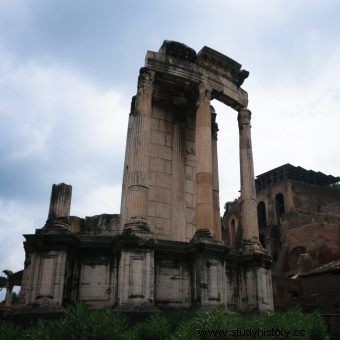The new year in ancient Rome was primarily associated with the day when the consuls took office. Initially, it was celebrated on March 1, i.e. the day of the festival in honor of Mars and Juno, and later the celebration was moved to January 1. How was the New Year celebrated before Rome became an Empire?
The new year was an extremely important event for the Romans. In a tradition dating back to royal times, it fell on March 1, when nature slowly began to come to life after winter. Along with the first gusts of spring, the Eternal City was also cleansed. On this day, the Roman calendar celebrated festivals in honor of Mars and Juno. It was also the only day of the year that the sacred fire was extinguished and re-ignited at the Temple of Vesta in the Roman Forum to bring prosperity to Rome in the new year.
Holy fire and cleansing the city
During the celebrations in honor of Mars, which lasted as long as 24 days, the most spectacular was the ritual war dance of the Hall held three times at that time. (priests of Mars). In late Bronze Age armor men performed a ritual dance through the city by striking swords against shields at the same time and stopping in certain places to dance the necessary parts of the procession to the sounds of the flute and singing. This ritual is now interpreted differently - as a preparation for the war season, driving out the evil spirits from the city and even as a magical support for the growth of cereals. One thing is certain - it was such an important event in the lives of citizens that African Scipio (who was one of the members of the Sali College) postponed for a month because of him crossing the Hellespont in 190 BCE

Anna Perenna left Carthage after her sister - Queen Dido committed suicide
At the same time, the city held a festival in honor of Juno - the goddess of women in childbirth, birth, sex life and marriage. According to mythology, Juno was also the mother of Mars, who was to be born on March 1. Only women took part in the celebrations taking place in her temple on Esquiline, and at that time they had to undo their hair and loosen their dresses so that, even in a symbolic way, nothing could block even a potential childbirth. From the time of Servius Tuliusz, after the birth of a child, a coin was deposited in the temple, which allowed the population of the city to be counted.

Image of Anna Perenna on a Roman coin
Panta rhei - but better be sure
The ancient Romans even wanted to be sure that time would not stand still, and that is why they celebrated a holiday in honor of Anna Perenna on the Ida. This goddess was the personification of the year (annus) and care for the continuity of years (perennis) and is associated with the basic myths about the founding of Rome. In one of them, she is portrayed as an old woman who, during a plebeian rebellion against raising taxes, sold pies to the rebels so that they would not starve to death. In another, she was to be the sister of the Queen of Carthage, Dido. When she took her own life after being abandoned by Aeneas at the behest of Jupiter, Anna Perenna left her homeland and came to Lazio. During her reunion with Aeneas, she was invited to stay at his house against his wife, Avalanche. The jealous spouse made Anna flee to a nearby stream, where the idol took her into the retinue of his nymphs.
It was for this reason that the festival in her honor was held by the river. At that time, whole families gathered in a grove near the Tiber River. We learn from Ovid that men and women in pairs dispersed around the area to feast . As many cups of wine were drunk as the years of life were prayed for . The feasts were accompanied by dances and prayers for the prosperity of the new year, and there was sexual tension in the air. The love aspect of this holiday was emphasized by Marcjalis, sharing his observation that at this time the grove "relishes with the blood of virgins"
In 1999, during a rescue excavation on the ancient Via Flamina in Rome, a rectangular fountain was discovered that operated here between the 4th century BC. and the 6th century C.E. The objects discovered in it and in its vicinity confirmed the habits described above. Moreover, Anna Perenna's forest was also a scene of magical practices. Discovered oil lamps, a copper bowl, enchantment tablets, and lead containers with figurines prove that both good and bad charms were cast here.
The celebration of the New Year in Rome was initially inextricably linked with the natural cycle. Their essence and significance were so deeply entrenched in the consciousness of society that they even survived the transfer of the new year to January 1. Their remnants could be found in the present day, although it may be a coincidence that alcohol was heavily sprinkled on the celebration of the feast in honor of St. Patrick's Day is March 17.

In the Temple of Vesta in the Roman Forum, sacred fire was burning continuously throughout the year, and once a year - on March 1, it was extinguished and ritually re-lit for the prosperity of Rome.
Bibliography:
- J. Horowski, "New Year in Ancient Rome", Filomata 1934 L.56.
- G. McIntyre, S. McCallum, "Uncovering Anna Perenna. A focused study of Roman Myth and Culture ”, London 2019.
- M. Piranomonte, "The Discovery oft he Fountain of Anna Perenna and ist influence on the study of Ancient Magic", Archeopress Publishing LTD, Oxford 2015.
- M. Piranomonte, F. M. Simón, "The daemon and the nymph:Abraxas and Anna Perenna, Bolletino di Archeologia on Line", volume Speciale, Rome 2008.
- W. Warde Fowler, "The Roman Festivals oft he period of the Republic. An introduction to the study of the religion of the Romans ”n, Port Washington, N.Y./London 1969.
